Over the past couple of weeks New Zealand entered into another snap lock-down caused initially by one community cases of the covid-19 delta variant.

So what does an Amigan do when he is locked up at home again? I know, work on volume two of the Vultures to Vampires book. To be honest I though I was really knowledgeable about the post Commodore history but the more I research, the more skeletons I dig up. If you thought that the Amiga story was complicated, you really should spare a thought for our 8-bit cousins. I’m discovering that the fate of the Commodore trademarks is even more intriguing and convoluted. If you want to find out more please check out our interview today with Amiga Bill on twitch.tv.
Link: Amiga Bill interview with David and Trevor
With the eBook version of volume one already released, David informed me the printed books have just arrived in the UK in preparation for shipment to the Kickstarter backers. A few weeks back I was sent a proof copy of the book for my review by the printers who are based in Turkey. I’m still waiting for the delivery. UPS contacted me last week to say they had misplaced the package which had arrived in Australia then disappeared. I explained I live in New Zealand which is 1,600 miles (~2,600 km) away. The UPS person apologised and said the drop off for NZ was Australia. Three days later I received another call from UPS to let me know they still hadn’t located my package. Last week they informed me the shipment was definitely lost and they were issuing a claim notice with the sender. Who said Commodore and Amiga was cursed? I think it was Dave Haynie, in Volume one of our book. 🙂
Floppy disks
Thanks to everyone who recently sent me birthday wishes. I received an excellent birthday card from one of my brothers, who shall remain nameless, mainly because his name features in a very early Billy Connolly monologue which I heard for the first time when I lived on the west coast of Scotland in the mid 1970’s. 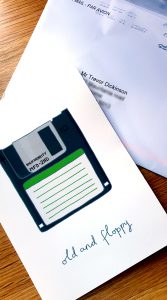 I have to admit just saying that makes me feel so old! 😉 Talking about age, if you are old enough to remember, floppy disks really were floppy. No, I’m not talking about the 3.5″ disk in the stiff plastic cases that we fed into our CBM 1581 drives and Amiga 500s. Back in time, floppy disks really were floppy. I first encountered 8″ floppies in the mid 70s. This was followed by 5-1/4″ floppies which I used with my CBM 2031 disk drive which was connected to my Commodore PET. That was soon followed by a CBM 1541 drive with my C64 and then a 1570 drive for my C128.
I have to admit just saying that makes me feel so old! 😉 Talking about age, if you are old enough to remember, floppy disks really were floppy. No, I’m not talking about the 3.5″ disk in the stiff plastic cases that we fed into our CBM 1581 drives and Amiga 500s. Back in time, floppy disks really were floppy. I first encountered 8″ floppies in the mid 70s. This was followed by 5-1/4″ floppies which I used with my CBM 2031 disk drive which was connected to my Commodore PET. That was soon followed by a CBM 1541 drive with my C64 and then a 1570 drive for my C128.
Not many people use antiquated electromechanical floppy drives these days, preferring floppy drive emulators which supports SD cards with gigabytes of storage (like the Gotek for the Amiga). Even the venerable C64 can be supplied with an 8GB SD card reader. I don’t know, call me old fashioned but would I install a jet engine inside my DeLorean if I had one? Hmm, it seems to me that part of the fun of classic computing is using the original hardware? Hey, who am I kidding, give me that jet engine, let’s burn some rubber.
Flattery and emulation to the MAXI!
A couple of years ago I purchased THEC64MINI retro gaming console. The cool little device is a scaled down miniature replica of the C64 breadbin model which emulates a Commodore C64. It’s supplied with 64 classic 8-bit games and can also be operated in C64 basic mode. I have to be honest, I did not recognise many of the 64 games supplied with the system, most probably because back in the day I was hooked on International Soccer, Football Manager and Superstar Soccer (did you notice the trend?) and really did not play many other games on my trusty C64. 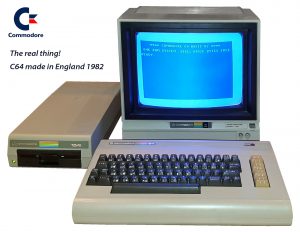 THEC64MINI came with a unique and intuitive carousel feature for game selection and I didn’t even have to read the user manual to get it up and running. (stand up everyone who said I never read the user manual ;-)) It was not supplied with a PSU but came with with a USB cable, which needed to be plugged into a powered USB port and an HDMI cable to connect to a TV or monitor with audio output. Unfortunately, at the time, only one of my HDMI monitors has audio output and that was not compatible with THEC64MINI so the games did not have the benefit of the classic 8-bit music or sound effects. THEC64MINI package came with a Competition Pro style joystick which included four extra buttons that enabled easy navigation of the excellent GUI. Although the joystick navigation was excellent the quality of the joystick itself was sub-optimal. It used a spongy gamepad type mechanism that spoiled gaming action. I also soon tired of scrolling through the game carousel to find the one I wanted to play. There is no keyboard on THEC64MINI, just a moulded plastic cover made to look like a keyboard. However, a USB keyboard could be connected to the second USB port which helped with entering text but if you’ve ever used a C64 emulator like Vice or C64Forever you will know how difficult it is to match the keys on a standard keyboard to the C64’s special key-set. I downloaded and updated firmware which allowed me to add and play additional games stored on a USB pen drive. The games certainly loaded a lot faster compared my C64, even though it is equipped with a fast loader, but with some games there was an almost imperceptible lag between operating the joystick and the resulting action on the screen. It was emulation after all, not the real thing. Despite being a well engineered product, THEC64MINI couldn’t match the C64 experience I remembered with such fond memories and it wasn’t long before I stored it away in a cupboard.
THEC64MINI came with a unique and intuitive carousel feature for game selection and I didn’t even have to read the user manual to get it up and running. (stand up everyone who said I never read the user manual ;-)) It was not supplied with a PSU but came with with a USB cable, which needed to be plugged into a powered USB port and an HDMI cable to connect to a TV or monitor with audio output. Unfortunately, at the time, only one of my HDMI monitors has audio output and that was not compatible with THEC64MINI so the games did not have the benefit of the classic 8-bit music or sound effects. THEC64MINI package came with a Competition Pro style joystick which included four extra buttons that enabled easy navigation of the excellent GUI. Although the joystick navigation was excellent the quality of the joystick itself was sub-optimal. It used a spongy gamepad type mechanism that spoiled gaming action. I also soon tired of scrolling through the game carousel to find the one I wanted to play. There is no keyboard on THEC64MINI, just a moulded plastic cover made to look like a keyboard. However, a USB keyboard could be connected to the second USB port which helped with entering text but if you’ve ever used a C64 emulator like Vice or C64Forever you will know how difficult it is to match the keys on a standard keyboard to the C64’s special key-set. I downloaded and updated firmware which allowed me to add and play additional games stored on a USB pen drive. The games certainly loaded a lot faster compared my C64, even though it is equipped with a fast loader, but with some games there was an almost imperceptible lag between operating the joystick and the resulting action on the screen. It was emulation after all, not the real thing. Despite being a well engineered product, THEC64MINI couldn’t match the C64 experience I remembered with such fond memories and it wasn’t long before I stored it away in a cupboard.
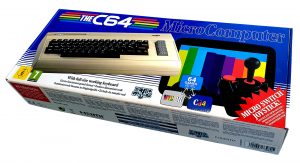
At the time Retro Games Ltd said an updated version with a full size working keyboard was in development and true to their word they came up with the goods. THEC64 (MAXI) is not available in New Zealand and I could not find one for sale on Amazon either. I managed to track one down on eBay from a UK retailer and was really surprised when it arrived in New Zealand eight days after I ordered it. There are plenty of unboxing videos and reviews on Youtube so I will concentrate on the major difference I discovered.
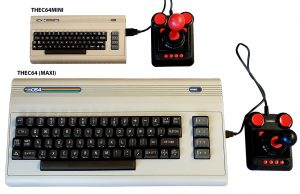
Inside the outer cardboard protective packaging is THEC64 retail box which, on the surface, looked remarkably similar to the packaging design on my original C64 box which I purchased in 1983.
The designers have used the same colour scheme and image layout with the obvious difference being the replacement of the Commodore name and logo with the [THEC64] logo and a discreet Retro Games Ltd. logo. I watched a video review by the 8-bit guy in which he noted several differences between his original C64 case and that of THEC64. His original C64, which presumably is a USA model, has a slightly difference colour and form factor. His video showed that the height of the THEC64 was slightly greater that his original C64 breadbin case but exactly the same size as the VIC20 case. However, when I compared THEC64 to my original C64 case the sizes were exactly the same height and shape. The case colour was almost identical too.
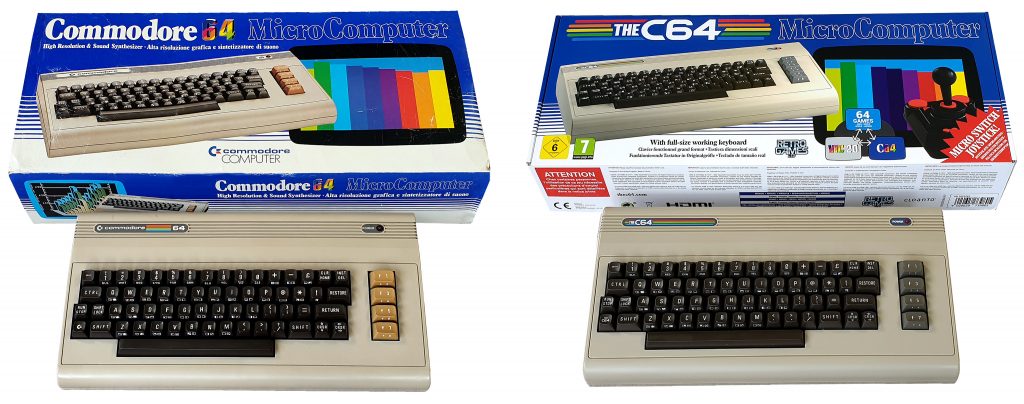
I agree with the 8-bit guy that visually the case plastic is a bit too shiny and looks a little cheaper compared to my original C64. Weighing in at ~1.5 Kg, the case is also a little lighter than the C64 which is ~0.2 Kg heavier. To make up for the lack of the Commodore name on the case decal, the rainbow colour strip is elongated but the [THEC64] logo is not embossed, neither is the [Power] text label next to the red power LED. The main keyboard keys are the same colour but the function keys are grey while my original C64 had tan coloured keys.
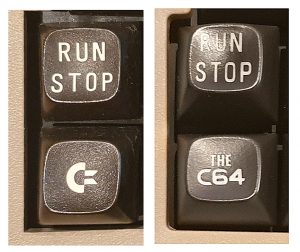
The other major difference is the shift key does not lock down when pressed and the key with the good old Commodore chicken lips logo has been replaced by the [THEC64] key, presumable for trademark reasons. In fact the Commodore name cannot be found anywhere on the case, packaging or in the quick guide manual, although the Classic mode screen does display the traditional [**** COMMODORE 64 BASIC V2 ****] text. Once again the ROMS have been licensed from Cloanto.
I am impressed with the keyboard which almost feels as good (or bad depending on your point of view) as the original. As this is an emulated C64 it does not have any of the C64 I/O ports so none of my original C64 peripherals can be used. However it does have 4 USB ports and an HDMI port along with a Micro USB B power socket. Personally, for durability, I prefer USB C for power sockets but I presume the Micro USB B version is less expensive? However, unlike the mini, THEC64 is supplied with a separate USB B power plug. Similar to its diminutive cousin, THEC64 is supplied with a Competition Pro style joystick but, unlike the earlier model, it has microswitches rather that the cheaper gamepad type mechanism supplied with THEC64MINI. Also the joystick handle is black rather than red.
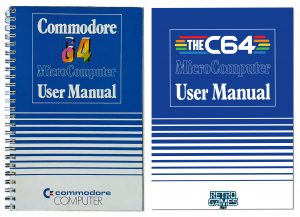
OK, now to test the beast! Using all the cables that came with the system, I connected THEC64 to my standard test rig which was set up for my A1222 beta system. With the power off, I connected the Joystick, the HDMI cable to the monitor and finally the Micro USB B cable to the power plug. I powered up the monitor and selected HDMI mode and pressed the power button on THEC64. The red power neon lit up and I waited for the monitor to burst into life….and I waited for the monitor to burst into life…. and I waited for the ….. OK. I think you get the message. Perhaps THEC64 did not like my monitor? I selected another HDMI monitor and went through the same procedure….. and got the same result! Fearing the worst, I disconnected the monitor from my X5000/40 and connected it to THE64. Exactly the same result again. The screen remained blank. Was the machine D.O.A, was this the Commodore curse striking again? I retrieved THEC64MINI and connected it to the same monitor. On applying power, the screen again gave me that blank stare! So unless the both machines were faulty it had to be either the PSU unit or the HDMI cable. I replaced the HDMI cable first and powered up THEC64MINI. This time the screen burst into life.
Now to check THE64. I connected it up again and hit the power button, after a couple of seconds the [Retro Games THEC64] splash screen was displayed on the monitor and shortly after that the machine booted to the initial setup mode.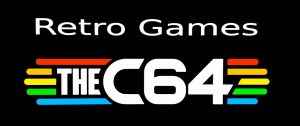 Who would have thought a brand new HDMI cable would be faulty? I was able to quickly set up my preferences using the joystick: Language: English; Display: European 4:3 CRT, Boot mode: Classic; Computer Mode: C64 PAL. THEC64 has a nice little bonus in that it also offers a Vic20 mode, not that I will be using that very much. I quickly checked out the GUI navigation which, apart from a few extra items, was almost identical to the very intuitive system introduced with the mini model. I visited the RetroGames website to check for any updated firmware and found new versions for both the Mini and Maxi machines. The firmware is very easy to update. Simply format a USB drive as FAT32 and copy the downloaded firmware file to the drive. Insert the USB drive and navigate to the [Device Settings/System information] menu. If the firmware on the USB stick is a newer version you will have the option of installing it, otherwise the file will not be shown.
Who would have thought a brand new HDMI cable would be faulty? I was able to quickly set up my preferences using the joystick: Language: English; Display: European 4:3 CRT, Boot mode: Classic; Computer Mode: C64 PAL. THEC64 has a nice little bonus in that it also offers a Vic20 mode, not that I will be using that very much. I quickly checked out the GUI navigation which, apart from a few extra items, was almost identical to the very intuitive system introduced with the mini model. I visited the RetroGames website to check for any updated firmware and found new versions for both the Mini and Maxi machines. The firmware is very easy to update. Simply format a USB drive as FAT32 and copy the downloaded firmware file to the drive. Insert the USB drive and navigate to the [Device Settings/System information] menu. If the firmware on the USB stick is a newer version you will have the option of installing it, otherwise the file will not be shown.
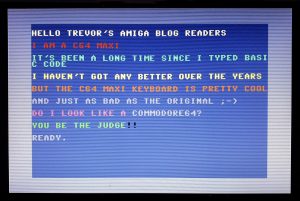
There are some new games supplied with THEC64 but after upgrading the firmware I was really eager to check out the new full size keyboard. As I said, I was never much of a games player (unless it was football). I changed to the Classic C64 mode and wrote a few line of Basic code. I have to be honest, I had forgotten how awkward the C64 keyboard is to type on but, after a few minutes it all came flooding back to me, 38 years later! I was pleasantly surprised. Now for the ultimate test, Superstar Soccer in 2021.
The game actually played OK on THEC64MINI, perhaps not quite as fluid as playing on a real C64, although I’m sure the spongy joystick did not help, but loading times were so much faster from USB. I purchased the game in 1987 to play on my C128D when I lived in the USA. I know that date is correct because the same unnamed brother I mentioned above visited me in Houston, Texas during his summer break from university. We played Superstar Soccer almost every day, whenever I had some spare time. Together we managed to create an all-conquering team that progressed from the division 4 eventually winning Division 1 and the Playoff final. Ah, those were the days.
Back to the test. As expected, Superstar soccer loaded really fast from the USB stick connected to THEC64. However, I could not get the joystick to work with the game. I connected a second joystick and was able to play the game with that but I had to continually switch between joysticks after each game finished. I then discovered that you can change the joystick port on the fly by pressing and holding the menu button on THEC64 joystick and pressing either button A or B to swap between joysticks 1 and 2. What was that about not needing to read the manual? The new joystick with its microswitches had that noisy but reassuring clickety-clack sound as I moved my diminutive striker around the screen chasing blocky 8-bit shadows as I struggled to recapture my performance of yesteryear.
As a comparison, I set up the game on my vintage 1983 Commodore 64. I loaded the game from the 1541 floppy disk drive. It took f-o-r-e-v-e-r to load the file, 92s to be precise even with a fast loader enabled, but finally the game loaded. It took 3s on THEC64, 1-0 to THEC64. Running the program once the file loaded, 36s on THEC64 versus 13s on the C64 with the compressed loader file. Score 1 -1 (although not really a fair test since the compressed file cuts out the program startup screen and credits.) The blocky 8-bit graphics just didn’t look right on a full HD 27″ monitor, even with CRT scan lines selected, compared to the image on my 14″ Commodore 1701 monitor, 2-1 to the C64. I’m sure the hi-fi experts would disagree but the 8-bit music and sound effects seemed about equal on both systems. Still 2-1 to the C64. Play-ability just about the same on both systems. Still 2-1. Overall ease of use, I’ve got to hand that to THEC64, 2-2. Expandability and compatibility with existing C64 peripherals, only one winner, 3-2 to the C64. Price and performance, has got to be THEC64, 3-3. Pure retro nostalgia – there’s only one winner here, 4-3 to the C64.
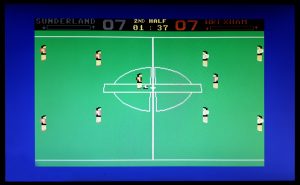
OK not the most scientific or objective of tests but overall I have to admit THEC64 experience with its faithfully reproduced full size keyboard is far better than I really expected. The joystick driven GUI is easy to navigate and if you can ignore the fact that none of the original C64 peripherals are compatible, then it’s a really good option if you want a relatively inexpensive, fast loading C64 which looks and feels like the real deal. If you are a fan of the Competition Pro style joystick then the updated version is a big improvement on the earlier model. If you don’t have a working C64 machine and are looking for an easy, clean C64 experience with a working keyboard then I can thoroughly recommend THEC64 and, at £122 plus shipping, the price is just about right for the casual retro gamer. You can even begin programming in basic again.
But if you are still a fully fledged C64 addict and really want total compatibility with your C64 peripherals and cartridges coupled with a turbo charged performance then THEC64 might not be the one for you. As you might expect, with the C64 the best selling home computer of all time, there are plenty of C64 clone options to choose from.
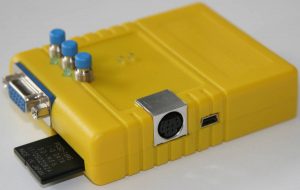
The pick of the crop are probably the FPGA based offerings which in theory should provide the best hardware emulation experience but usually at a much higher price. The Turbo Chameleon 64 V2 cartridge from Individual Computers which retails for €214.39 can be used with a C64 or, if you don’t have a C64, in stand-alone mode.
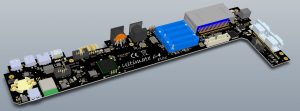
For the ultimate turbo charged experience you should check out the aptly name Ultimate64, a replacement C64 motherboard designed by Gideon Zweijtzer who also created the The 1541 Ultimate cartridge. A new version called the Ultimate64 Elite is available to pre-order for €239 from the Gideon’s Logic website.
Amiga Mini (me)
If you are wondering about my interest in THEC64, its quite simple. A couple of years ago, Retro Games registered THEAMIGAMINI trademark in the UK and, as recently as May this year, registered the THEA500 trademark, both in Classes 9 and 28. Quite an impressive feat given the current legal dispute over the control and ownership of the “Amiga” brand. Given that Retro Games hold both trademarks you might have expected that it would developed a product using one of those names. Instead the company recently announced it is developing THEA500MINI console, a scaled down version of the Amiga 500 which is available to pre-order on Amazon for £ plus shipping. It is very similar to THEC64MINI concept, featuring an arm board running an Amiga software emulator in a miniaturised replica case but this time styled like the Amiga 500. The joystick has been dropped and is being replaced with a gamepad and replica Amiga tank mouse. The 64 8-bit games are being replaced with 25 classic Amiga games. According to the publicity it will emulate an Amiga 500, 600 & 1200 (ECS/OCS/AGA). Once again the Amiga ROMs have been license from Cloanto Corporation and the product is scheduled to be released in March/April next year.
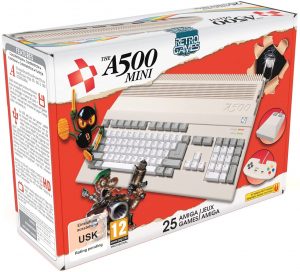
Will it be as successful as THEC64MINI? It’s difficult to say. David Pleasance estimated that ~27 million C64s were sold while the total Amiga sales are thought to be around 25% of that number. There are a lot of hard core Amiga enthusiasts who already have access to a host of excellent FPGA clones which can accurately emulate multiple retro systems, not just the Amiga hardware. There are also Amiga software emulators on PCs and other hardware like the Raspberry PI. I think TheA500MINI will appeal to someone who used an Amiga but has since moved away from the scene and wants a quick and easy way to replay the popular Amiga games of their youth.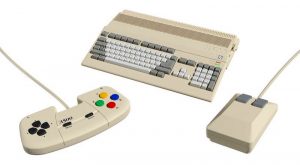
However, if Retro Games were to develop a full size MAXI version with a working keyboard I think that would potentially attract a lot more die-hard Amigan fans. Hackers are already replacing the arm board inside THEC64 with systems like the Mister to achieve near perfect hardware emulation provided by C64 FPGA core. I can imagine the same happening if Retro Games were to create a full size THEA500 Maxi, especially if it were priced at a similar level to THEC64. Anyway, only time will tell.
Retro mania
Returning to the 8-bit theme, I was walking along the waterfront the other day, prior to the latest lockdown, when I noticed a Wellington Museum billboard advert promoting the Poly-1 micro. Having lived through the early days of the microcomputer revolution, I thought I knew all of the micros that were developed from the MITS Altair in 1975 and Chuck Peddle’s 6502 which powered many of the early 8-bit micros. My first computer was a Commodore Pet and I took interest in all the early models which were mostly developed in the UK, USA and Japan. However I had never heard of the Poly-1, a microcomputer which was apparently developed in New Zealand for schools and education.
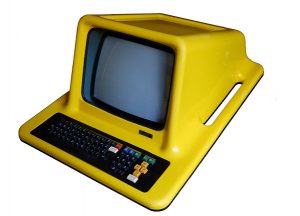
After a little research I discovered that it was a fully integrated all-in-one computer (a bit like the Commodore PET) designed by Neil Scott and Paul Bryant of the Wellington Polytechnic School of Physics, Electronics Telecommunications and Electrical Engineering (now Massey University) to serve the New Zealand school market. Back in 1980 Scott, with a team of six engineers and technicians, began to design and build an advanced microcomputer using the best technology that was available at the time. The first prototype, code named Polywog, was was built using off the shelf components which included a Motorola 6809 CPU with 64 KB RAM and a video card which displayed 8-colour 40 column high resolution graphics on a 14″ Philips colour monitor. This was almost 2 years before the C64 was released. The NZ Government’s Development Finance Corporation (DFC) formed a partnership with Progeni Computers, a successful New Zealand software business, to create Polycorp to manufacture and and distribute the Poly-1 as the first ever computer custom designed for schools and teaching, pre-dating the BBC Micro from Acorn Computers in the UK.
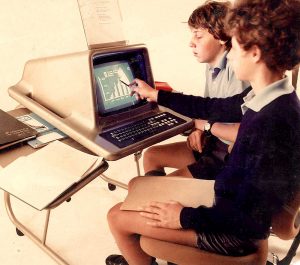
Fifty working prototypes were built before the Poly 1 was released in 1981. By that time it included a built-in colour monitor and keyboard all enclosed in a moulded fibreglass case with carry handles. It also included SAA5050 teletext, 6840 clock, 6854 networking and with the addition of a separate Proteus module up to 32 Poly-1s could be networked. A network of computers in every school connected to a file server. File servers connected by phone-lines to a centralise mainframe. Software build in pairs with teacher with programmer. This forward thinking vision in 1980 was truly amazing. Unfortunately it would not last.
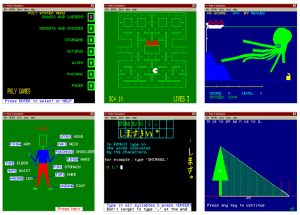
Although the project was initially supported by the New Zealand government they eventually reneged on a $10m Ministry of Education agreement to purchase 1000 units over 5 years. The then Minister of Regional Development, Warren Cooper reportedly remarked that he and his colleagues “could see no reason why Government should spend money so that teachers could do even less work”. Sigh, what happened to that forward thinking!
There was no doubt it was expensive but NZ could have been at the forefront of the evolving microcomputer revolution! A lower cost version, the Poly-2. was produced which cost NZ$3,775 for the Poly-2, monitor and Proteus module. However, major price cutting by Apple, who dumped the Apple II Plus on the NZ market at an educational price of NZ$1200 (the normal retail price was NZ4,812) killed any competition.
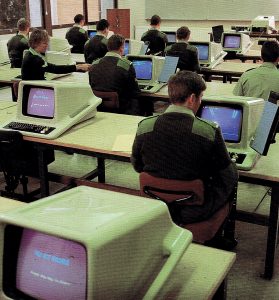
The project didn’t die overnight. Progeni took over the joint company from the DFC and began marketing the Poly-1 in Australia. In all, only a couple of thousand units were ever sold, some went to the Australian army who operated Poly-1 network for a number of years.
A Poly-C model was released but, despite its technical superiority it could not compete with the cheaper IBM PC clones. Now where have I heard that before? The Poly computer line was discontinued in 1989 after the struggling BNZ bank called in its loans forcing Progeni to go out of business.
For more information please visit the Poly-1 preservation project and Terry Stewart’s blog.
Birthday greetings
 In case you missed the news, 2021 marks the 30th anniversary of the Linux kernel. In 1991 Linux Torvald a young Finnish graduate student announced on the comp.os.minix Usenet group that he was developing “a (free) operating system (just a hobby, won’t be big and professional like gnu) for 386 (486) AT clones.” Thirty years later Linux rules the computer world. It powers most websites including social media giants such as Facebook, Google and even Wikipedia. It dominates the cloud and is even the most used OS on Microsoft Azure platform and don’t mention supercomputers, the top 500 all run Linux. And to top it all, if you include Android, Linux is also the most popular OS for end users. Not that bad for a hobby development.
In case you missed the news, 2021 marks the 30th anniversary of the Linux kernel. In 1991 Linux Torvald a young Finnish graduate student announced on the comp.os.minix Usenet group that he was developing “a (free) operating system (just a hobby, won’t be big and professional like gnu) for 386 (486) AT clones.” Thirty years later Linux rules the computer world. It powers most websites including social media giants such as Facebook, Google and even Wikipedia. It dominates the cloud and is even the most used OS on Microsoft Azure platform and don’t mention supercomputers, the top 500 all run Linux. And to top it all, if you include Android, Linux is also the most popular OS for end users. Not that bad for a hobby development.
Happy Birthday Linux, but you are still younger that the AmigaOS which turned 36 this year. That’s all for this update,,,,,, opps, I almost forgot, if you were looking for an update about the A1222 Plus check out my Soapbox article in the next edition of Amiga Future magazine.
Until next time………………………….